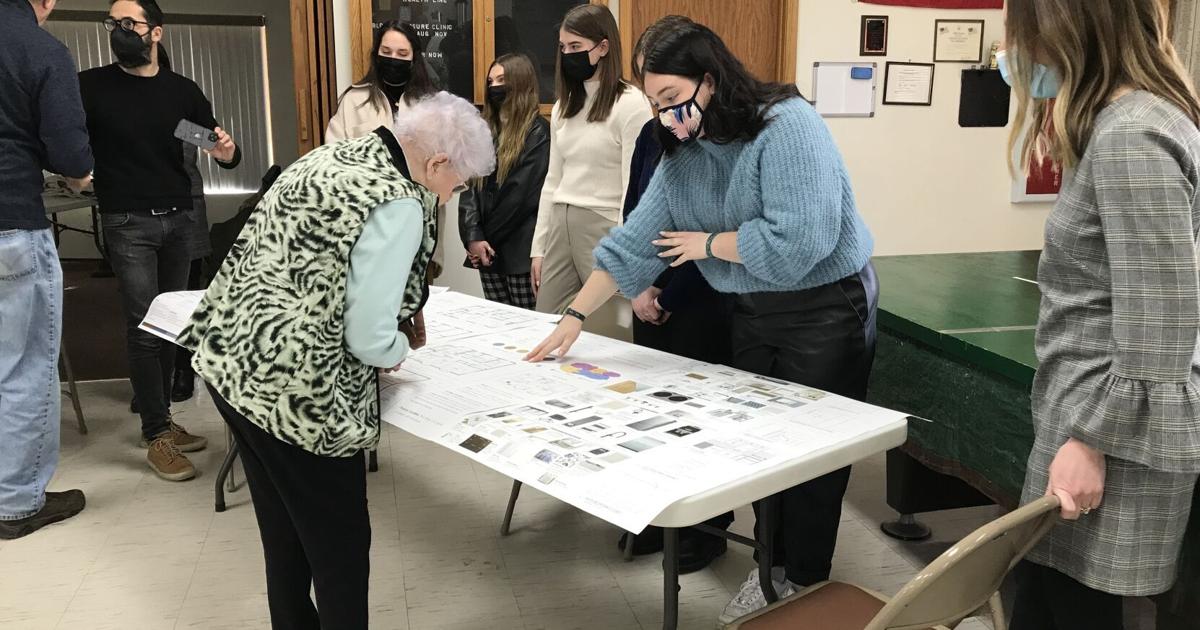
Iowa State University student Brooklyn Wissbaum points out features of Noriene North’s home and what to modify.
Small home improvements could help an aging Iowan population stay in their homes longer instead of going to nursing homes.
Iowa State University (ISU) students, in conjunction with AARP Iowa and the city of Charles City, presented their home modification blueprints to their clients and the community on Tuesday at the Charles City Senior Center. The plans were done to aid aging adults stay in their home longer and give simple changes.
The plans were part of the “Revitalizing Small Communities for Aging Population in Iowa: Making Home Modifications More Accessible,” project initiated by ISU assistant professor of interior design Daejin Kim.
Kim has made it a focus of his to research the concept of “aging in place,” which allows older adults to live safely in their homes.
According to a press release, aging in place has significant positive implications for older adults as it allows them to stay in their homes as well as helping to slow declining populations in rural communities. Kim and the student’s project specifically looked at rural communities, because of how little research has been done.
People are also reading…
The project builds off of work Kim did for two years alongside ISU associate professor of architecture Cameron Campbell, associate professor of community and regional planning Biswa Das, and former ISU assistant professor of landscape architecture Sungduck Lee. The group developed a home assessment tool to be part of an aging-in-place home modification strategy and manual.

Iowa State University students Krista Smith, left, and Brooklyn Wissbaum were part of several students presenting home modifications on Tuesday.
Kim’s design students went to work with an actual client in Charles City, and presented the best plans last week. AARP Iowa funded the home modification project and helped to find older adults to work with.
“I think this is a major opportunity for students, because in a previous year, we had to create a client,” said Kim. “We just imagined our client and their information. This year, we have a very specific problem. We can get more practical design strategy to address many kinds of issues.”
ISU students presented their poster presentations, which included information on the layout of the houses and what issues they had to address, to a group of over 30 people. Students addressed the physical issues their client has and what simple modifications can be done to aid them, such as adding a hand railing at a key point of their house. The students had been working on the project for four weeks, according to Kim.
“We were also given our floor plan and we assessed the floor plan and kind of decided what can we change about it,” said sophomore Brooklyn Wissbaum. “What can we move around within this home without fully changing the entire home? Because a big thing we kept in is displaced attachment, which is your familiarity with the space.”
Sophomore Krista Smith and Wissbaum worked with Noriene North’s home and her space. Solutions that the two had for North was storage space and easier access with a walker. Smith and Wissbaum kept in mind North’s hobbies, like piano and crafting.

Iowa State University students Jordan Gilispie (left), Makayla Bristol, Sydnee Hannegrefs (right) with their home modification plan.
North said she enjoyed looking at the presented home modifications, particularly the idea of knocking out a wall in her home for better accessibility. “They work great for senior citizens and for my house,” said North.
Sophomore Makayla Bristol, who worked on a home modification plan for an older man, said her biggest takeaway from being a part of the project was understanding future design changes as people age. Sophomore Sydnee Hannegrefs, who worked with Bristol, said it was exciting to have a client see their final product.
“It’s really rewarding to see (the client’s) reactions and how important the little things can be, even if we don’t think they are, they are definitely important,” said Hannegrefs.
AARP Associate State Director and Community Outreach Connie Eastman said the main goal with the plans is pointing out some of the low cost solutions for the community members. She added she hoped the individuals at the event were able to go home and install easy solutions for their lives.
“The overarching plan in our mind — and I know it is for ISU as well — we wanted to model this for other small rural communities,” said Eastman. “We want people to know that you can keep people in their homes if you just make some modifications.”
Abby covers education and entertainment for the Globe Gazette. Follow her on Twitter at @MkayAbby. Email her at [email protected]








More Stories
Interior Design Color Management – How To Use Color And Create A Beautiful Home
Self Build Directory
Build a Shed In Your Backyard With Little or No Woodworking Experience